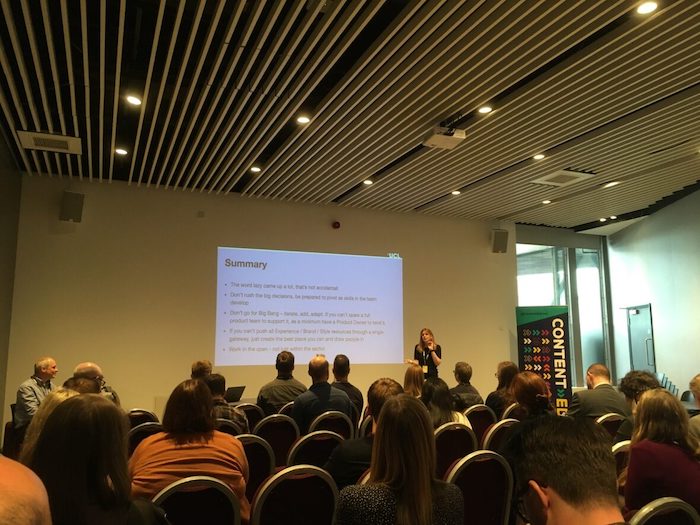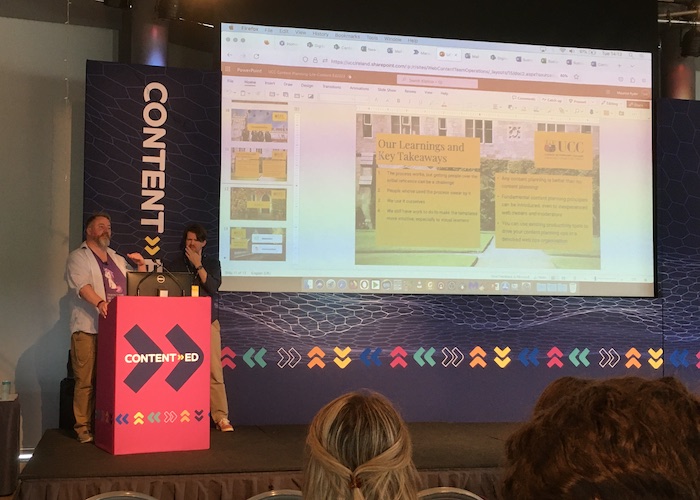ContentEd 2023
What is ContentEd?
Every year, the content strategy consultancy Pickle Jar Communications organise ContentEd, a conference that brings together people who work with web content in the Higher Education sector. Delegates tend to be based in the UK, and from what I can tell, mostly work in areas like Marketing, User Experience and Content Operations. Along with colleagues from the University of Edinburgh, I travelled down to Manchester to find out what’s going on in the big wide world of Higher Education web content.
There were a lot of thought-provoking talks. In the interest of brevity, I’m just going to write here about two that I particularly enjoyed.
Saying ‘No-No’ to digital anarchy: unleashing the ‘know-how’ of design systems
Samantha Fanning and Vincent Harding, University College London User Experience team
This was a great talk. Samantha and Vincent talked us through the journey they’d been on as they introduced a design system at UCL.
In case you’re wondering what a design system is, see:
Design Systems 101 – article by Nielsen Norman Group
The main message Samantha and Vincent had was that introducing a design system had been difficult but worth it. They started by describing some of the opposition they faced.
Challenges of launching a design system
The first problem was an interesting philosophical one: UCL has a culture built around a long history of challenging convention. UCL was the first university in England to be entirely secular, and it was one of the earliest institutions to admit women. Today, one of their slogans is “Disruptive thinking since 1826.”
But whichever way you cut it, a design system involves some level of conformity. There isn’t a lot of room for renegade interpretations and disruptive thinking. It’s more about unambiguous guidelines for a more consistent experience. So Samantha, Vincent and their colleagues had to make it clear why conforming to the standards within the system was the right thing to do in this particular case.
Second, they presented a list of worries they had encountered among designers in the UCL community.
These included fears that a design system would:
- let too many people think they can do design
- make designers lazy
- be a time sink
- be a central land grab away from designers
Samantha and Vincent acknowledged these points, but argued that without a set of standards, there’s no consistency and you end up designing things again and again.
A design system makes life easier for teams building digital products
Design systems effectively work as a style guide and tech resource explaining how to use digital components.
A component might be something like a button. When you define what a button looks like and provide the code behind it, you save colleagues time. Designers and developers can take the code for that button, safe in the knowledge that it’s been tested, and that it’s functional, usable and accessible. Without a resource like that, anyone who needs a button for their project has to reinvent the wheel.
Vincent presented an impressive yet terrifying collection of reinvented wheels from across the UCL web estate. Without established conventions, users were being confronted with a dizzying array of components, colour palettes and interaction patterns.
The Component Gallery: examples of components collected from a range of design systems
Design systems also introduce a more evidence-based process to resolve disagreements. Samantha described the situation before they had a design system: when there was a disagreement about what something should look like, the decision would be passed upwards to someone more senior. But that person would often be several steps removed from the evidence required to make it.
That’s far from ideal. With the design system in place, those disagreements didn’t even need to happen in the first place, because the decision’s already been made. And where they are happening, they’re happening with reference to evidence.
A design system makes life easier for users
It’s also worth noting that a design system makes life easier for users. That’s because:
- a design system brings consistency
- consistency makes interfaces more predictable
- predictable interfaces are easier to use.
With a design system in place, users can move around your web estate knowing how the navigation works, what’s clickable, and so on.
Get the foundations right
Samantha and Vincent described how there had been some painful moments.
One that stood out concerned a clever tool that they’d employed to handle the spacing of elements on different screen sizes. It seemed like the tool worked brilliantly and it had been baked into the foundations of the design system.
Unfortunately they later discovered it was a resource hog and it was slowing things down. But by that time, it was everywhere. Vincent encouraged us to spend time on foundational elements like this. You can’t get everything right first time, but if you can get the foundations right, you’ll save yourself a lot of pain.
A connected piece of advice was to keep it simple. The more complexity you build in at the foundations, the harder it is to change course later on.
Vincent also recommended getting your naming conventions sorted out early on. With a common language in place, discussions between UX, Design and Development team become easier, because you’re all talking about the same thing.
Utility drives adoption
Samantha and Vincent finished by emphasising that in a devolved university environment, you typically can’t mandate the use of a design system. So your colleagues need to find it useful, as that’s what drives adoption.
Find out more
Here’s the listing page for Samantha and Vincent’s talk:
Saying ‘No-No’ to digital anarchy: unleashing the ‘know-how’ of design systems

Samantha and Vincent explaining how they introduced a design system at UCL
Content Planning Lite: A Gateway to Better Content Planning in Universities
Maurice Ryder and Cal Doyle, University College Cork Web Content Team
Managing sites in a devolved environment
Maurice and Cal talked about how they manage the creation of new sites at UCC. Like Edinburgh, they have a devolved web estate where people manage web content at a departmental level. At UCC, there are 380+ websites and 800 local moderators.
In an ideal world, those local moderators would build sites according to a methodical design process. They’d start with user research, and then build up a list of user needs. After that, they’d develop their information architecture, page outlines and content, and finish with a beautiful website.
A pragmatic approach to content planning
Maurice and Cal had a slide with this ideal process mapped out. The next slide was that process with a big thick line through it.
They described the real world: time-poor colleagues for whom creating a website is one of many tasks that need to get done in the working week. While the full process is still the best way to make a website, they needed to develop a simpler version that covered the basics.
To handle this, they developed a new approach they call Content Planning Lite.
One aspect of this was a series of short videos for website moderators that took them through the essential stages of content planning:
- First principles comms plan
- Define key messages
- Identify audiences
- Create user and job stories
- Identify content needs
- Create content architecture (site structure and page outlines)
Then anyone requesting a site has to complete a form showing that they’ve thought about audiences, user needs, and how their site will meet those needs. The form also requires named people to be responsible for the content.
Using Power Automate to reduce admin tasks
Maurice showed us some neat stuff he’d done with Power Automate behind the scenes. When someone submits their form, this generates a new folder in SharePoint with planning documents for the site. There was also a clever tracking system that lets Maurice and Cal keep tabs on where various sites are in the development process.
Any planning is better than no planning
I liked the pragmatism of UCC’s approach. Maurice said that any content planning is better than no content planning, and it’s hard to argue with that.
Find out more
Here’s the listing page for Maurice and Cal’s talk:
Content planning lite: a gateway to better planning for devolved web content in universities

Maurice and Cal talk us through how they manage web content
Great conference, would go again
ContentEd 2023 was great. There was a gang of us travelling down from Edinburgh, and it was fun seeing familiar faces in between sessions.
Also, our colleagues over in the Prospective Student Web Content Team picked up three awards, which was fantastic. Read more about that here:
We were big winners at the ContentEd 2023 Awards
At the end of the conference, the organisers announced that the next ContentEd will most likely be in June 2024. I’d thoroughly recommend it if you work in this area — there were lots of interesting talks and the focus on Higher Education meant that it was relevant to the kind of challenges we deal with at Edinburgh.

Heaven knows I’m cheerful now: two days of sunshine in Manchester

